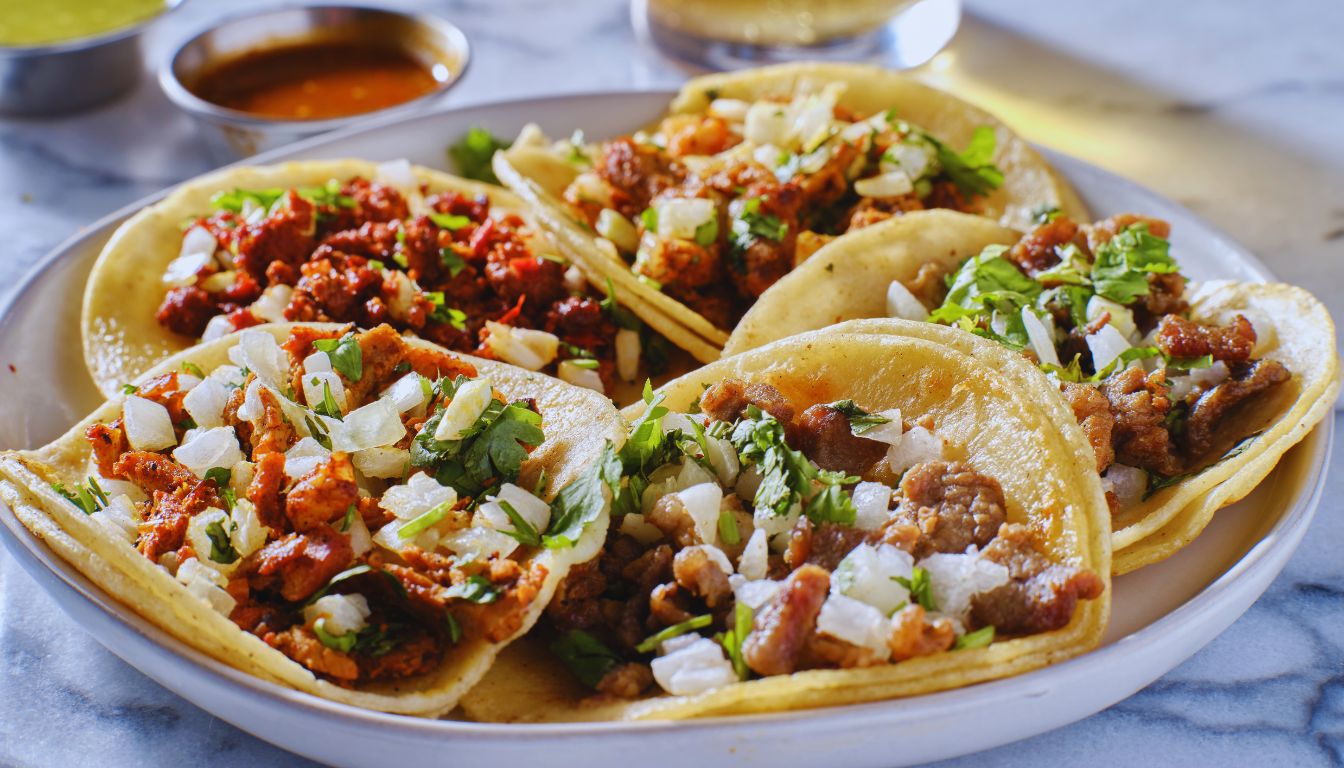Tacos al Pastor, Mexico City Mexico
The sizzling sound of marinated pork slowly rotating on a vertical spit, the sweet aroma of caramelized pineapple, and the skilled hands of taqueros slicing meat directly onto warm corn tortillas – this is the sensory symphony that defines Mexico City’s most beloved street food, Tacos al Pastor. This culinary masterpiece tells a fascinating story of cultural fusion, bringing together Mexican ingenuity with Middle Eastern influences to create what has become an iconic symbol of Mexico City’s vibrant street food scene.
Table of Contents
Historical and Cultural Significance
The story of Tacos al Pastor is a testament to Mexico’s rich history of cultural adaptation and culinary innovation. In the 1920s and 1930s, Lebanese immigrants brought their traditional shawarma-making techniques to Mexico, introducing the vertical spit-roasting method known as “trompo.” Mexican culinary artisans embraced this technique but transformed it by replacing lamb with pork and incorporating local ingredients and flavors.
The name “al Pastor” (meaning “shepherd style”) pays homage to the Lebanese shepherds who introduced this cooking method. Over time, this fusion creation became deeply embedded in Mexico City’s cultural fabric, evolving from its Middle Eastern roots into something uniquely Mexican.
Today, Tacos al Pastor represents more than just street food – it symbolizes Mexico City’s ability to embrace diverse cultural influences while maintaining its distinctive identity. The dish has become such an integral part of Mexican cuisine that in 2019, it was ranked as the world’s best traditional dish by international food critics.
Ingredients and Preparation
The art of creating authentic Tacos al Pastor involves several key components:
- The Marinade: A complex blend of dried chilies (guajillo, achiote, and chipotle), herbs, spices, and aromatics
- The Meat: Thinly sliced pork shoulder, marinated for 24-48 hours
- The Assembly: Layers of marinated meat stacked on the vertical spit
- The Pineapple: Fresh pineapple crowned at the top of the trompo
- Essential Accompaniments:
- Fresh corn tortillas
- Finely chopped onions
- Fresh cilantro
- Lime wedges
- Salsa roja or salsa verde
The preparation process is a time-honored ritual that requires skill and patience. The meat must be stacked carefully on the trompo, allowing it to rotate and cook slowly while developing a crispy exterior. The trademark touch is the pineapple placed at the top, its juices naturally basting the meat as it cooks.
Where to Try It
Mexico City offers countless opportunities to experience authentic Tacos al Pastor:
- El Huequito (Historic Center): Operating since 1959, this legendary spot is known for its perfectly caramelized meat
- El Tizoncito (Condesa): Claims to be the birthplace of Tacos al Pastor
- Los Cocuyos (Centro Histórico): A 24-hour taquería famous for its traditional preparation methods
- Chupacabras (Coyoacán): Notable for its extra-large portions and vibrant atmosphere
For the most authentic experience, visit these spots between 7 PM and midnight when the trompos are in full swing and the atmosphere is most lively.
Eating Etiquette and Customs
Understanding local taco customs enhances the dining experience:
- Stand while eating – most authentic taco stands don’t have seating
- Use both hands – one to hold the taco, one for adding garnishes
- Never use a fork and knife
- Add lime, onions, and salsa gradually to maintain the perfect balance of flavors
- Two to three bites maximum per taco – they’re meant to be eaten quickly while hot
Seasonal Considerations
While Tacos al Pastor are available year-round, the experience varies by season:
- Peak Season (October to March): Perfect weather for street food exploration
- Rainy Season (June to September): Look for stands with covered areas
- Festival Times: Special events like Día de los Muertos (November) offer unique atmospheric experiences
Modern Interpretations
While maintaining respect for tradition, some innovative takes include:
- Vegetarian versions using seitan or mushrooms
- Gourmet interpretations in upscale restaurants
- Fusion variations incorporating global ingredients
- Alternative proteins like chicken or beef
Practical Information and Travel Tips
- Best Times: Visit stands between 7 PM and midnight for peak freshness
- Price Range: 15-25 pesos per taco at traditional stands
- Safety Tips:
- Choose busy stands with high turnover
- Look for clearly visible meat preparation areas
- Ensure proper food handling practices
- Language: Learn basic ordering phrases in Spanish
- “Uno de pastor, por favor” (One pastor taco, please)
- “Con todo” (With everything)
- “Sin cebolla” (Without onion)
Making Your Tacos al Pastor Journey Memorable
Embrace the full cultural experience by visiting different stands throughout your stay, engaging with local taqueros, and learning about their unique preparation methods. Take time to appreciate the artistry of the trompo preparation and don’t hesitate to try different combinations of salsas and garnishes. Remember, each taco stand tells its own story of Mexico City’s rich culinary heritage.













